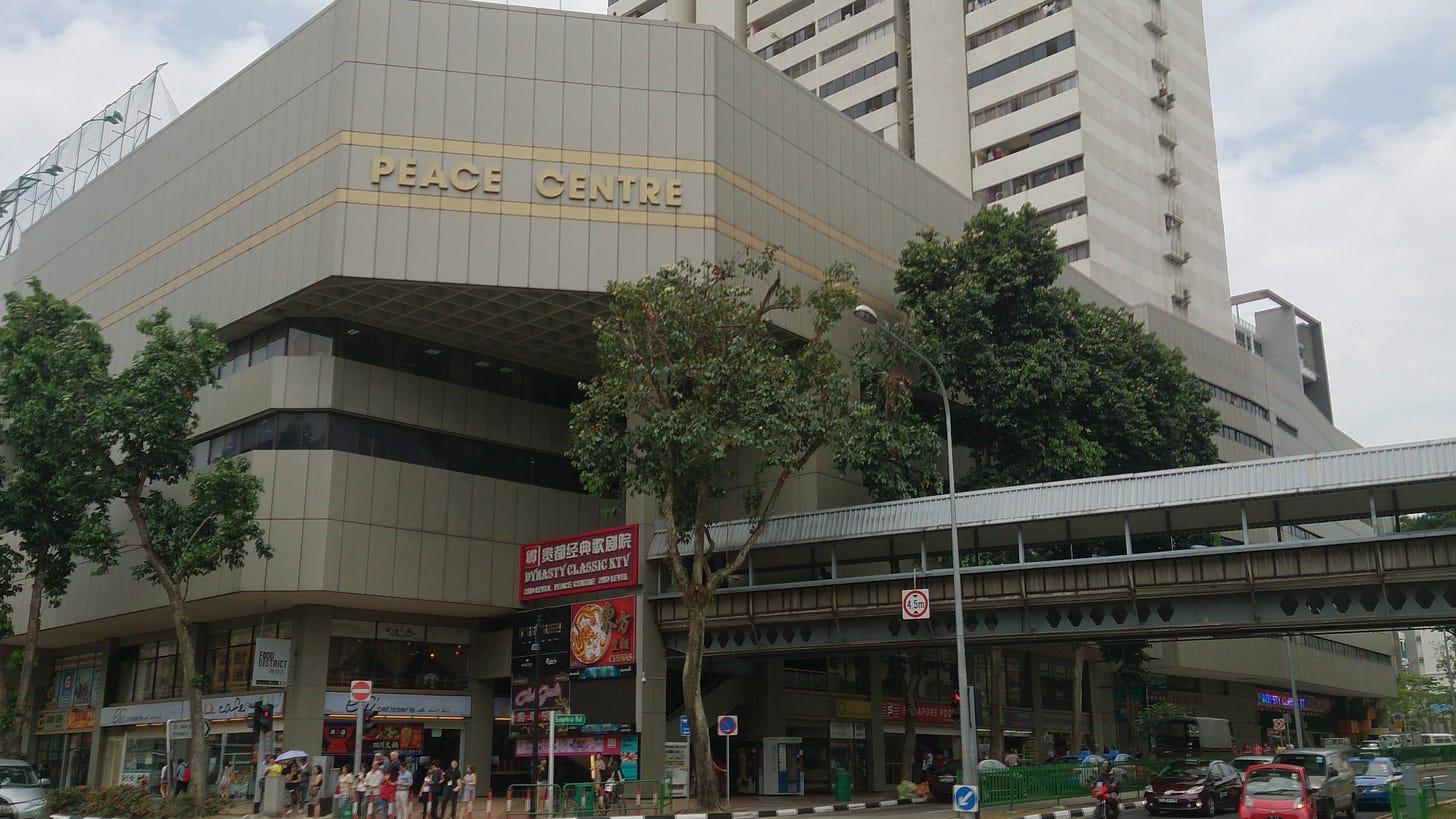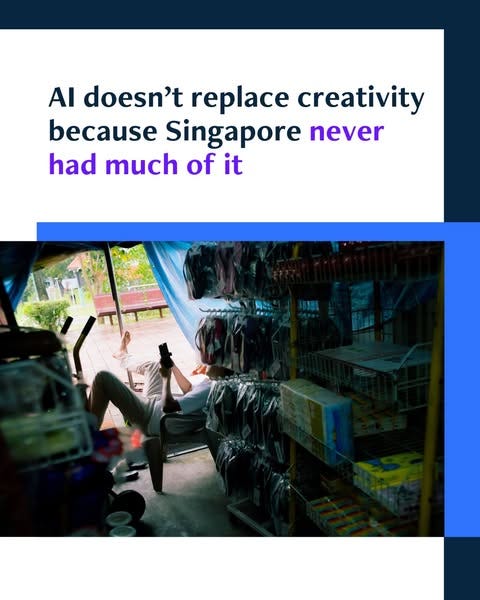In defense of Singapore's creative class
Many argue the highly-polished city-state lacks creatives to make it culturally exciting. The reality is decidedly more complex.

Earlier this month, Singaporean digital publication Rice Media published an article on the city-state openly embracing artificial intelligence (AI), particularly generative AI, in daily life and business operations.
In it, writer Yeo Ker Siang argues that Singapore’s predisposition for optimization resulting from the Ten Year Series template, referring to official compilation books of past examination papers which students are trained to work with to prepare for their own exams.
Yeo posits that this process put greater emphasis on memorization and efficiency rather than self-discovery and problem solving, further driven by tuition centres. As such, Singaporeans exist as “regurgitation machines” in an “anti-disruption culture,” demonstrated by a uniform visual culture seen across cafés and fashion — or lack thereof.
On several levels, Yeo’s argument makes a compelling case for a phenomenon that’s increasingly being denounced by students and papers across Singapore: the education system, despite its world renown, does very little to encourage social skills and critical thinking. In fact, some have argued it even tries to dissuade students from these altogether.
But beyond this, the premise of Yeo’s article relies on a deterministic assumption, one that Singaporeans simply lack creativity at their core, rather than it being the result of a careful approach chosen by the ruling People’s Action Party (PAP) in a global capitalist context.
In the comments section of the Instagram post for the article, many Singaporean users built on his point to advance that the quick turn to genAI for copywriting, digital marketing, and other important key jobs in business today, is evidence that Singapore had always lacked creativity and was bound to embrace ChatGPT, Midjourney, and other AI tools of the like.
The turn to genAI as a substitute for real art commissioned from artists is a phenomenon of global concern, transcending the borders of Singapore. It’s largely driven by companies’ profit-maximizing incentive, cutting corners on artist fees for ad campaigns so long as genAI’s output is faster and cheaper, regardless of quality.
It’d be revisionist to deny that Singapore society isn’t bound by rigidity and an almost classist commitment to social structure. The government’s push to lay “the five C’s” as the foundations of the Singaporean dream — namely cash, car, credit card, condominium, and country club membership — can largely be blamed for this, and there’s a farcical element to Lawrence Wong’s ForwardSG plan for governance trying to reverse this trend today, without admitting there was once a government impetus to espouse this social belief.
Looking at the considerable efforts that came from the PAP to social engineer Singapore this way, many important factors come up explaining the Lion City’s seeming ‘creative desert’.
Singapore is widely considered to be one of the most expensive cities in the world, frequently boasting one of the highest costs of living compared to Western metropoles, and even more so compared to its regional counterparts such as Kuala Lumpur, Jakarta, Ho Chi Minh City, or even Bangkok.
Taking into account the costs of food, daily necessities, and sky-high rental prices, it becomes nearly impossible for artists and creatives to survive in the city-state to live off their art, especially when the city-state offers few government programmes allowing artists to dedicate their time to making art in the first place.
Yeo’s article touches on another issue, but somehow fails to address the root cause behind it: Singapore’s quest for optimization and affinity for comfort & familiarity also means that certain job tracks are preferred to others. The result is funnelling students into STEM fields, studying business without a clear idea why, or what specifically attracts them to it besides being repeatedly told that’s where the money is.
The children are hardly to blame; there is very little societal respect or even understanding of careers that stray from this neatly-traced path. Trying to explain to your parents’ friends, or relatives during family holidays, that you’re a full-time artist might get you clumsy questions, raised eyebrows, or a potent side-eye.
Read more:
This isn’t to say public support should determine an individual’s career choice, but in the societal context of a city as strict as Singapore, it’s not hard to see how this might act as a deterrent for people to freely pursue.
Strictness also comes in the form of actual, legal barriers that further undermine creative projects. Anyone who has ever had to deal with the Infocomm Media Development Authority (IMDA) to procure the required license for hosting an art exhibition, music performance, rave, or any other kind of art-related gathering, would know the frustration that comes with this level of bureaucracy.
Dismissing Singapore for having little creativity without looking at the legal framework artists have to operate in feels incredibly disingenuous, if not condescending.
Just a few days after Rice Media’s article came out, an example highlighting the complexity of the issue at hand came up in the news. On June 20, Wild Rice, a notable Singapore professional theatre company, had its production Homepar pulled by the IMDA and Ministry of Home Affairs (MHA), accusing it in a joint statement of “glamorising drug abuse.”
In an Instagram post addressing the IMDA-MHA statement, Wild Rice defended the production saying it seeks to ask “why real people, in our society, turn to drugs, often as a response to trauma, discrimination, and marginalisation.” The company expressed its disappointment over the authorities’ decision to pull a work in progress, adding that “the arts must have the space to explore complex, often uncomfortable realities.”
The eagerness to explore difficult, sensitive topics in Singaporean society, and the harsh reality of legal repercussions for choosing to do so, sheds light on a key issue faced by Singapore’s creative class, which is given little to no attention in Rice Media’s assessment of why creativity doesn’t thrive in the little red dot.
Read more:
It’s also ironic that, just one day after publishing the article, Singapore’s daily newspaper The Straits Times announced that local artist Charmaine Poh had won Villa Romana Prize, Germany’s oldest and one of its most prestigious art awards. A co-founder of independent media outlet Jom, Poh previously had her work presented at the Venice Biennale 2024. Two important milestones that are admittedly difficult to achieve if we assume that Singapore does, in fact, lack creativity.
Singapore’s quest for cultural identity is undoubtedly one of its biggest looming question marks after decades spent consolidating its socio-economic power. The complexity of a multiracial society, the city-state’s historical ties to British Malaya and Malaysia, its quick rise to global city, all highlight the difficulty of narrowing down what makes people Singaporean today.
There have also been notable attempts at creating grassroots spaces for the arts, with independent enclaves such as Pearl’s Hill Terrace, Peace Centre, or Golden Mile Complex. The latter two have since been closed down and being repurposed for mixed-used developments by authorities instead; the former’s fate remains unknown beyond 2026.
Artists provide an important voice fleshing out the cultural landscape for their peers. They face incredible challenges and barriers in doing so, ones that must be acknowledged and preferably addressed if we want to have an honest conversation on genAI’s growing competition to the local creative class.







